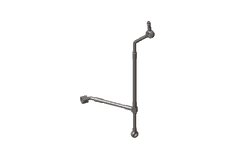Introduction
The Cummins 5589144 Vent Tube is a component designed for use in commercial trucks. It serves a specific function within the truck’s system, contributing to the overall efficiency and safety of the vehicle’s operations. Understanding its purpose and role is fundamental for maintaining and optimizing truck performance.
Basic Concepts of Vent Tubes
A vent tube is a component that allows for the release or intake of air within a system, facilitating pressure equalization and preventing the buildup of unwanted gases or fluids. Proper ventilation is vital for maintaining system efficiency and safety, as it helps to regulate pressure and temperature, ensuring components operate within their designed parameters 1.
Purpose of the Cummins 5589144 Vent Tube
This Cummins part plays a role in the truck’s system by enabling pressure equalization and managing fluid levels. It ensures that the system operates smoothly by allowing air to escape or enter as needed, which is crucial for maintaining the integrity and performance of the truck’s components 2.
Key Features
The Cummins 5589144 Vent Tube is constructed with materials and design elements that enhance its durability and performance. Its material composition is chosen for resilience against the harsh conditions it may encounter, while its design incorporates features that improve its functionality and longevity. Unique characteristics may include specific fittings or connections that ensure a secure and efficient integration into the truck’s system.
Benefits of Using the Cummins 5589144 Vent Tube
Incorporating this part into a truck’s system offers several advantages. It contributes to improved system performance by ensuring proper ventilation and pressure management. Additionally, its durable construction and design elements support longevity and reliability, reducing the need for frequent replacements or repairs.
Installation Considerations
When installing the Cummins 5589144 Vent Tube, it is important to follow guidelines and best practices to ensure compatibility with the truck’s model and system. Proper fitting and function are crucial for the vent tube to perform its intended role effectively. Detailed instructions and considerations for installation help in achieving optimal performance and safety.
Maintenance and Troubleshooting
Regular maintenance practices are recommended to ensure the longevity and efficiency of the Cummins 5589144 Vent Tube. This includes periodic checks for wear or damage and ensuring it remains securely fitted. Common issues that may arise include blockages or leaks, which can be addressed through troubleshooting tips that focus on identifying the problem and applying the appropriate solution 3.
Safety Considerations
Safety protocols and considerations are important when working with the Cummins 5589144 Vent Tube. This includes handling, installation, and maintenance safety measures to protect both the equipment and personnel. Adhering to these guidelines helps in preventing accidents and ensuring a safe working environment.
Environmental Impact
The use and disposal of the Cummins 5589144 Vent Tube should be considered in the context of environmental impact. Eco-friendly features or recycling options may be available, contributing to sustainable practices in the automotive and heavy-duty truck industry.
Cummins Overview
Cummins Inc. is a leader in the design, manufacture, and distribution of engines, filtration, and power generation products. With a history of innovation and a commitment to quality, Cummins offers a wide range of products designed to meet the needs of various industries, including automotive and engine components. The company’s dedication to excellence is reflected in its product offerings, including the Cummins 5589144 Vent Tube.
Conclusion
The Cummins 5589144 Vent Tube is a critical component for maintaining the efficiency and safety of commercial trucks. Its role in pressure equalization and fluid management, combined with its durable construction and design, makes it a valuable part of the truck’s system. Proper installation, maintenance, and adherence to safety protocols are essential for maximizing its benefits and ensuring a safe and efficient operation.





